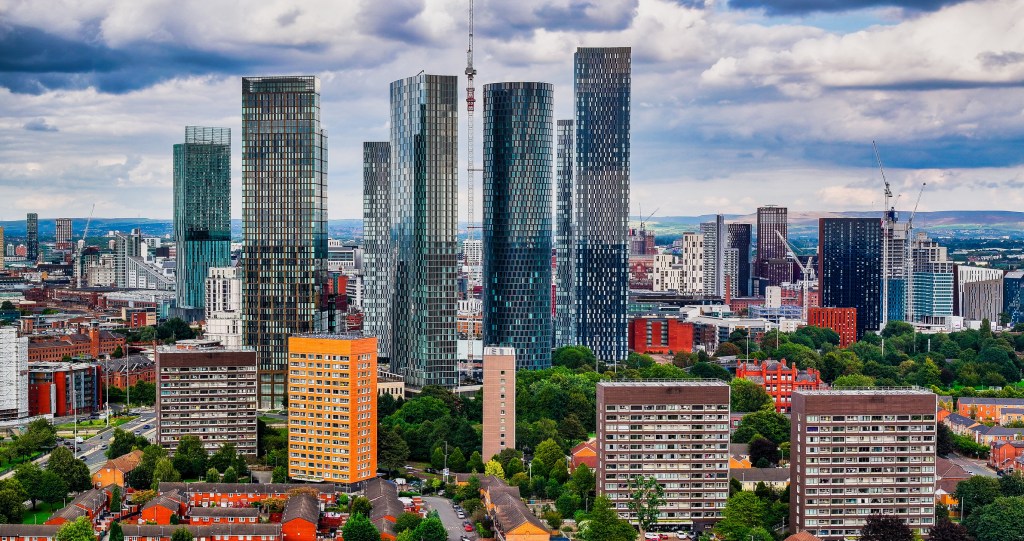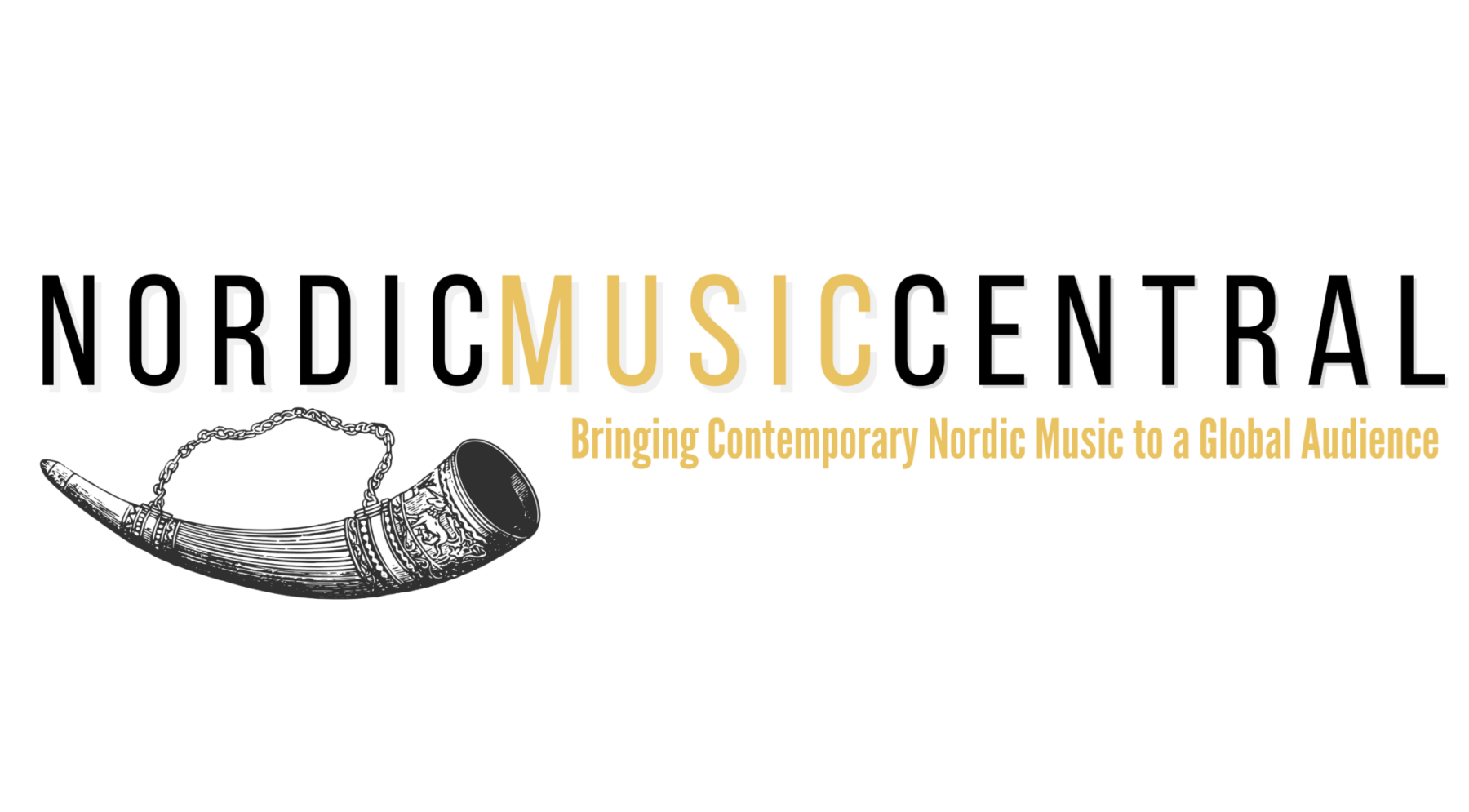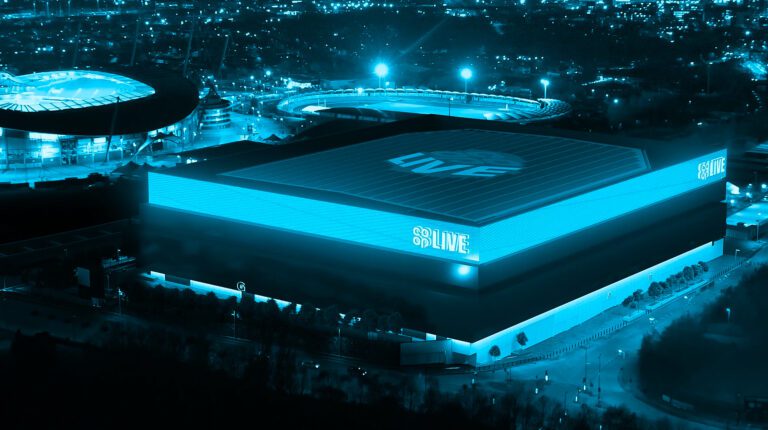Weekend Intermission is our regular feature where we look at an artist or band or breaking news not from the Nordic countries, just to mix things up a bit.
On 23rd April the £365 million Co-op Arena, known as Co-op Live, situated right next door to Manchester City’s Etihad Stadium, about two miles (3.2 km) from Manchester city centre, opens to the public, in an area that 25 years ago was a post industrial wasteland.
It will be the biggest musical arena in the UK (and specifically ‘designed’ for music according to the publicity), taking that claim to fame away from the AO Arena in the city centre, which was built in support of Manchester’s bid for the 2000 Olympic Games and which opened in 1995.
Depending on how you interpret ‘arena’ the two together are arguably the biggest two in Europe.
Co-op Live’s capacity is 23,500 while the AO Arena’s, which has been extended in a makeover, is 23,000. That means potentially 46,500 music fans under a roof at the same time in two venues in one city in the case of full houses.
The AO Arena, which has had a variety of sponsors’ names since it opened, was for several years in the 1990s the busiest in the world as measured by event attendees, even eclipsing New York’s Madison Square Garden. The Co-op arena will doubtless do the same in due course.
And both of them are 200 miles from London, which is still the only place in the UK some people, including, I’m sad to say, those in the music business, still seem to have heard of.
For those interested in the history of the Co-op arena’s conception (at the beginning of the pandemic, which was pretty risky) and the politics involved, I have posted in the Archives section of Nordic Music Central a copy of an article I wrote for another publication in September 2020. See https://www.nordicmusiccentral.com/from-the-archives-does-manchester-really-need-the-two-largest-music-venues-in-the-country/
My focus here is on what this development means for the music industry generally and specifically in Manchester. What does it say about that?
After a ‘trial’ opening gig by the born-again 1980s popster Rick Astley, the official opening event at Co-op Live will see a two-night stint by local but nationally popular comedian Peter Kay, who once worked as a security guard at the AO Manchester Arena, followed by the first musical show, the Black Keys.
Thereafter follows a litany of top artists and bands including Olivia Rodrigo, Keane, Take That, Elbow, Eric Clapton, Barry Manilow, Nicki Minaj and The Eagles, all before the end of May.
Later in the year sees The Pet Shop Boys, Liam Gallagher, The Killers, Megan Thee Stallion, Stevie Nicks, Kings of Leon and Justin Timberlake; in total almost 40 top acts that have been booked before the place even opens, easily the majority of them being music ones.
Clearly the future for this venue looks rosy. As for the AO Arena there is a noticeable change in its emphasis. It always was a ‘general’ arena. After all, its raison d’être was to host sporting events and there have been more Monster Truck smash-ups there than I care to remember.
And I see that even netball is on the menu now.
It still retains some top names. Peter Kay’s stint at the Co-op is a short one. He will appear at the AO regularly throughout the year, his spiritual home I suppose.
Musically though the venue seems to have slipped back from the top of the Premier League to mid-table, with more ‘Championship’ level artists appearing to use a football analogy, some of whom are unlikely to attract anywhere near the capacity. Some of them I have never heard of.
The biggest names I can find between now and the end of the year are Girls Aloud, Heart, Alice Cooper, Nick Cave and the Bad Seeds, Deep Purple, The Corrs and The Human League while ‘compilation’ events (numerous artists branded under one name such as ‘Clubland’) are becoming more common.
Of course Manchester has numerous other large venues accommodating an audience of over 1,000 including the Bridgewater Hall, the Albert Hall, the O2 Apollo, the Lowry, Aviva Studios, Home, New Century Hall and Academy 1.
It is better off by far than any other ‘provincial’ UK city in this respect.
I have no doubt that if Taylor Swift was to come here (for some oddball reason she didn’t on her Eras tour) she could have a six month residency at either the Co-op or the AO.
But my concern is what is happening at grass roots level. The first thing you notice when you see the artists listed above is that the majority of them are legacy acts. It’s my guess that the average age of the artists and the audience alike would be close to the requirement for a bus pass. (And I have seen recent photos of music gigs at the AO where they have inserted additional seating in the standing area, which is almost as big as a football pitch).
The future seems as bright as ever for these ageing artists and bands in their giant arenas but down in League 2 to return to that football analogy it is not. By which I mean ‘starter’ and small venues.
While it is usually the case that new venues will open to replace old ones that close, and Manchester still has more gigs per capita than anywhere else in the UK (I think that is ‘per capita the city of Manchester’, not Greater Manchester), the city has lost too many of its established venues in recent years including Tiger Lounge and Dry Bar – both well-loved music venues with colourful histories -and other iconic ones such as Ruby Lounge, Sound Control, and Roadhouse.
The Deaf Institute and Gorilla almost went that way during the pandemic but were saved at the last minute.
And it is still happening. A relatively new and sophisticated venue, Canvas, in a trendy area, closed in February.
Night and Day on Oldham Street, until the late 1990s the most run-down major city street in the country, now at the heart of the Bohemian ‘Northern Quarter’, perpetually faces the prospect of closure on account of complaints about noise from local residents.
And those residents are, strangely, half the problem. Until the massive 1996 IRA bomb, which destroyed a large section of the city centre, only a few hundred people lived in it. The bomb prompted a rebuilding process, a reversal of decades of shift to the suburbs, which has resulted in a population of around 25,000 now, and as many close by in inner-city Salford.
New apartments are consistently being built, many of them in high rise buildings in what is referred to as ‘Manchattan’.

But those apartments require space; the land occupied by music venues and the non-residential units in them are supermarkets and vape shops; not for music.
The problem is compounded by rampant building work catering to a burgeoning student population in what is the biggest city centre academic conglomeration in Europe.
The changing habits of students and young people generally are impacting the live music sector seriously. Especially post Covid, they don’t go to so many gigs and don’t drink alcohol. That is why there are so few nightclubs as well.
(And there is nothing new where alcohol is concerned. The lack of alcohol sales to teenagers who were already high on ‘Es’ was at least partially responsible for the closure of The Hacienda, and that was in 1997).
So you’ve more chance of getting heard now at a community pub in the suburbs if you can convince the landlord to host you instead of a covers singer or karaoke. And those pubs are disappearing, too.
Interestingly, there was talk of the Co-op Live venue hosting start up nights for artists and bands or having ‘side shows’ for them on the nights when big acts are playing.
That proposal caused some consternation amongst small venue operators but I can’t find any specific mention of it on the arena’s website, which does major on its ‘community’ action, which includes donating money to charitable causes.
It would be nice to see both of these giant arenas and perhaps some of the other big venues, donating a fraction of ticket revenue to help keeping live music going in small venues across the city but I don’t see it happening.
The AO Arena is owned by a private equity group and the Co-op venue is majority owned by a US financier, Oak View, and the City Football Group but with input from Harry Styles (One Direction). He came into the music business by way of a TV talent show, not a back room in a tiny venue. What assistance can start-up artists expect from him? Only time will tell.
One thing I would have liked to see (and I did suggest this to Oak View four years ago) is a venue catering specifically to the 7,500-12,000 audience category, which London has, but not Manchester since gigs are no longer put on at the Manchester Central exhibition and commercial event venue.
Ultra large venues can be too expensive for bands in that category and there are many of them.
That could only happen now if the Co-op venue was set up to be ‘split’ (as the smaller Factory International/Aviva Studios was at the design stage) and that isn’t going to happen. Could it at the AO? Probably not, but the ‘size’ of their booked acts is decreasing.
But for the many, many small and start-up artists and bands what these two big arenas means for them, as opposed to the strolling bones that will mainly appear there, is very little presently.
They will bring big names for sure, probably more so than in any other comparable European city. But that is all.



